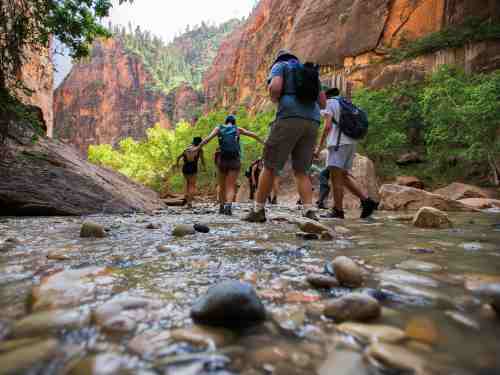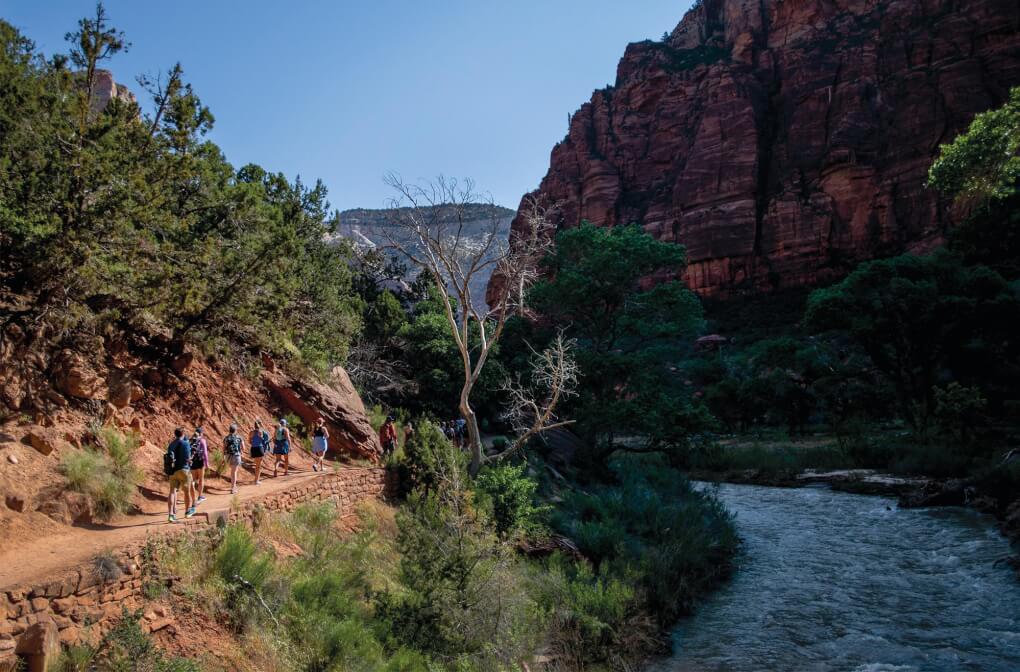In a Zion National Park shuttle bus, GVSU students prepared for their next hike: Scout’s Lookout via the West Rim Trail. During the 25-minute ride, a look out the window provided a breathtaking view of natural rock formations, the Virgin River, and lush, green plants on the riverbanks that almost feel out of place in the desert. A voice recording on the bus pointed out common plant life, like watercress and maidenhair ferns. “Even the plants in Zion tell the story of water,” the narrator said.
The story of water is exactly what students explored.

Following ‘The Peters’ adventurous lead, students walk through shallow waters at Zion National Park to go climb a giant rock.
As part of the inaugural Water in the West program, they participated in a high-impact learning experience that offered a first-hand look into water issues facing the U.S.
The program satisfied curriculum requirements for Meijer Honors College students with two weeks of online coursework prior to and following a four-week trip to the southwestern U.S. With stops in Colorado, Utah, Arizona and New Mexico, the trip allowed students — many for the first time — to witness the delicate balance within the Colorado River’s water system. It presented a very stark change to the predictable and abundant water system in Michigan.

Students gain a new perspective on the vast landscapes of the West. After kayaking 10 miles in the Colorado River, they spent the next day hiking Horseshoe Bend, seeing the river they had kayaked from 1,000 feet above.
Students shuffled off of the bus, applied another coat of sunscreen and awaited further instruction from the trip’s geology professors, Peter Wampler and Peter Riemersma (referred to frequently by students as “The Peters”). Wampler quizzed them on the cross-bedding — the geological phenomenon where the movement of sediment by wind and water results in visible, angled lines in rock formations — on the mountains they would soon be hiking, asking which way the wind must have been blowing millions of years ago in order for the rocks to look that way. It was one of the things students learned before leaving on the trip.
Questions like that from the Peters became routine for students, prompting them to pay greater attention to the natural world around them. In fact, the crossbeds in Zion were one of Lillie Waldron’s favorite memories.



The inaugural Water in the West group is pictured, flanked by the Peters on the top ledge; Peter Wampler is at far left and Peter Riemersma is at far right.
“You can look at these crossbeds and see which way the wind was blowing and the water was moving millions of years ago,” said Waldron, a junior studying biochemistry. “We have this connection to millions of years ago right in front of us. It’s something I wouldn’t even have thought about if [the Peters] weren’t here with me.”
It’s just one example of the kind of learning that best takes place outside of the classroom.
“It’s one thing to go to a lecture and learn the facts. But it’s another thing to spend hours hiking around Zion and Bryce Canyon and Arches,” Peter Riemersma said. “It’s the difference between learning something briefly and truly experiencing it.”
On a trip with two geology experts, a graduate assistant, two teaching assistants, and 21 students with majors ranging from legal studies to mechanical engineering to natural resource management, each member of the group contributed their own unique knowledge through car rides, long hikes and nightly group dinners.
Wampler and Riemersma have both led similar trips before. They said the wealth of diverse knowledge that students have is what makes a study-away trip so powerful.

Peter Wampler gives instructions before a hike.

The group left their hotel at 3 a.m. in order to see the sun rise in the Grand Canyon.
“The value of the experience is that you’re sharing it with people who have their own perspective, and they can share things about their experience that enhances your experience,” Wampler said. “Everybody had something to share. There’s a lot of things like that that make it more educational than to be on your own.”
Between discussions of water discharge and fluvial crossbeds, students also made discoveries about themselves and their future career paths.
“Part of the research that I would like to do is to research happiness,” said Morgan Braddock, a sophomore studying psychology. She added she hopes to pursue cognitive neuroscience.
“One thing that keeps people happy is learning and having new experiences,” Braddock said. “Whenever we experience something new, we have a flush of dopamine. This experience with Water in the West was like nothing I’ve ever done before. It makes me want to keep doing new things.”

After a 3.6-mile hike with 1,1115-foot elevation gain, students Alli Miller and Corrine Worthing find a moment to laugh and take in the views from Scout’s Lookout.
For Mia Heimbaugh, a sophomore, the experience out West opened her eyes to career possibilities that she hadn’t considered. “I’ve always been very passionate about the environment,” she said. In her hometown, when it was proposed that a section of woods be torn down to build more neighborhoods, Heimbaugh helped create a petition and encouraged people to sign it to preserve the woods. Water in the West not only introduced her to others with similar passions and interests, but also to major and career opportunities.
“I remember talking to Peter Wampler after we climbed a volcano, and he said, ‘So, you thinking about becoming a geologist?’ And I thought about it for a second. I was like, ‘You know what? That actually sounds really cool.’ That’s why I’m still up in the air about my major, because there’s so many opportunities that were presented during this trip.”
If Water in the West provided one common takeaway for Wampler, Riemersma and the students, it’s that sometimes the most life-changing parts of the trip are not initially on the itinerary.
A highlight of the trip for many was Red Reef Park, in Utah, a stunning landscape of red rocks shaped by water over the years. The group did not plan to stop at Red Reef until the teaching assistants discovered it on their day off. The hike wasn’t without its challenges, though, which required students to assist one another to reach the end.

Grace Cairy and Molly DiCosola take a moment to sit after the day’s hikes, taking in the stunning sights of Zion National Park.
The experience ended up being one of Wampler’s favorite moments. “It was just on the edge of their ability. They couldn’t do it if they didn’t work together,” he said. “It was really cool to see them overcome this obstacle and to help each other, and then feel confident that they had done something cool.”
Watching students who struggled during the Red Reef Park hike (their second hike of the day) help others, one might think they had known each other for years. But 10 days prior, students were meeting each other and making final preparations for the trip. Some were so nervous, they considered not going.
“Going in, I was so nervous. I almost didn’t want to go,” said sophomore Molly Dicosola. “I didn’t really know anyone. It hit me right before we left that I was going to spend a month with a bunch of strangers.”
For Dicosola, the trip was especially nerve wracking for another reason: an ironic fear of water.
“When I was in swim class, I couldn’t even jump off the diving board because I was so nervous. I kind of have a fear of deep water.”
By the end of the trip, she was cliff jumping into the water at Blue Hole, New Mexico.
“I realized this is a once-in-a-lifetime opportunity,” Dicosola said. “I was like, ‘No matter what, I’m gonna do everything. I’m gonna go for it.’ I would have never, ever in my life imagined doing that.”
Not only did Dicosola face her fear of water, she also gained a new perspective of herself and her potential career path.
“Being in a new environment with new people brings out a new side of you,” she said.
While some students learned to recognize their need for space and time alone on the trip, the experience taught Dicosola that she is more extroverted than she knew. “I realized that I want to work with nature but I also want to work with people,” she said.
A “leave no trace” presentation for kids and families presented by a Zion National Park Ranger made Dicosola consider potential jobs at national parks. “I just feel so much more comfortable now. I know that it will be a good experience, because it will be a new experience,” she said.







